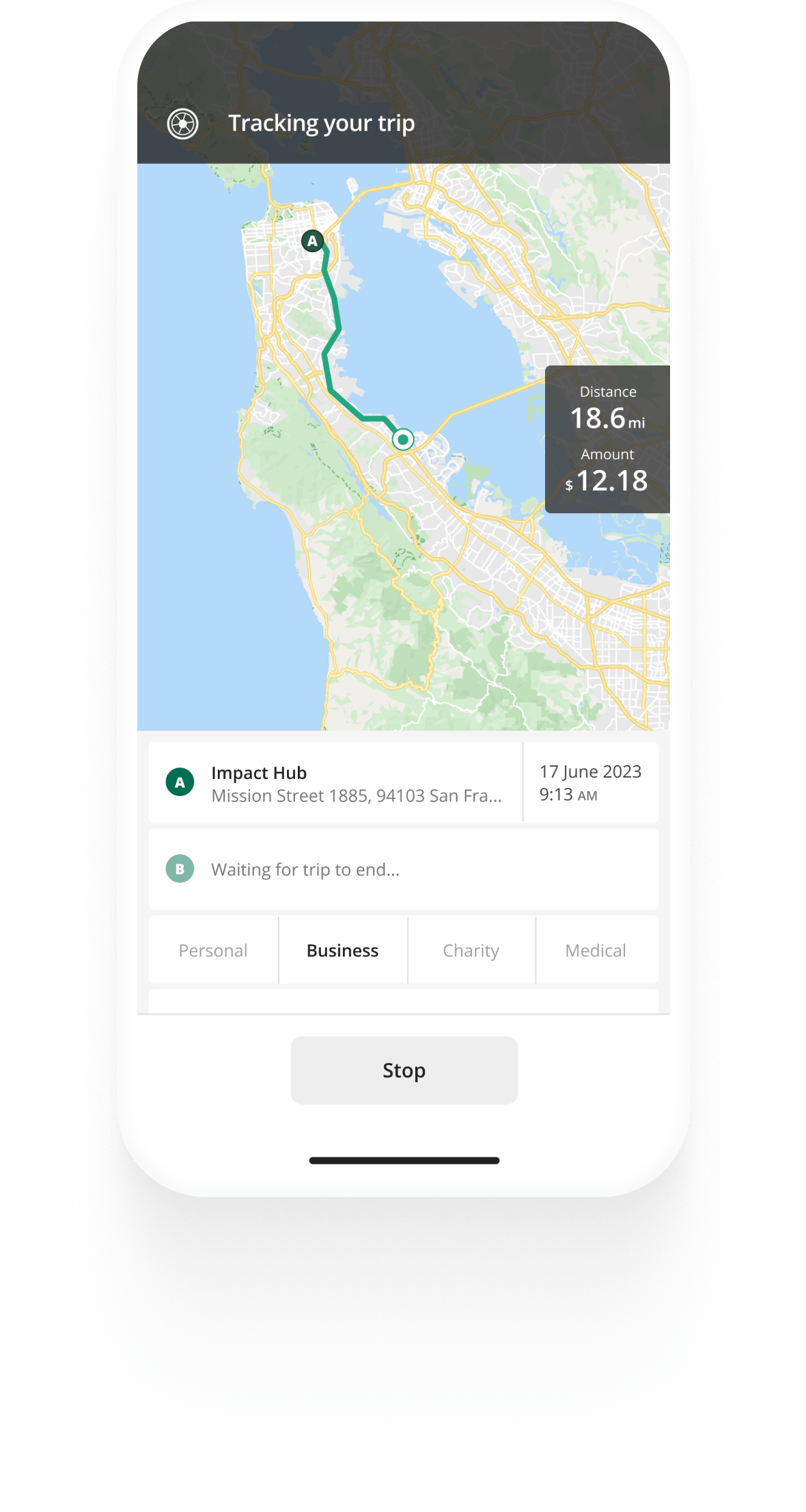Track mileage automatically
Get startedHow To Calculate Your Mileage Reimbursement
The process on how to calculate mileage reimbursement is straightforward. You need to take into account:
- The current IRS mileage rate
- The associated tax rules that apply to your situation
- How you stay compliant, e.g., how you need to document or report on your business mileage
IRS rate for calculating mileage reimbursements
You can use the annual official mileage rate the IRS provides to calculate mileage reimbursement or deductions.
The 2025 IRS standard rate is 70 cents per mile, and the 2024 rate is 67 cents per mile.
To illustrate, here's a simple example of how to calculate your mileage reimbursement:
You have kept mileage records throughout January 2025. Your logs show you've driven 180 miles for business. The 2025 standard mileage rate is 70 cents per mile.
To find your reimbursement, you multiply the number of miles by the rate:
[miles] * [rate], or 180 miles * $0.70 = $126
Calculate mileage reimbursement for work
If you work for a company and drive your personal vehicle for business purposes, you can ask your employer for reimbursement—or they might already have a mileage reimbursement program.
Be aware that the standard IRS rates are guidelines for reimbursement for work. This means the company can use the standard IRS rate, as in the example above, or set its own rate.
The employer also decides how the reimbursement program works. You can also be reimbursed as lump sum allowances or FAVR (fixed and variable reimbursement).
What if the company mileage reimbursement and IRS standard rates don't align?
If you get reimbursed at a higher rate than the IRS standard, the excess amount is taxable in most cases. Getting reimbursed below the standard rate might violate the Fair Labor Standards Act (FLSA) if it causes an employee's earnings to fall below the federal minimum wage. So employers should be mindful of this.
Some states, such as California, Illinois, and Massachusetts, have laws requiring mileage reimbursement.
Curious to calculate mileage reimbursement for 2024 or 2025?
Use our calculator for standard or custom rates below.


Mileage tracking made easy
Trusted by millions of drivers
Automate your logbook Automate your logbook

Automatic mileage tracking and IRS-compliant reporting.
Get started for free Get started for freeCalculate mileage for taxes
If you're self-employed, you can claim a tax deduction for your business driving.
There are two different methods you can use:
- The standard mileage rate method
- The actual expenses method.
Now, let's dive into the two methods and list some pros and cons.
Standard mileage rate method
If you're looking for a simple way to calculate mileage tax deductions, use the standard mileage rate method. This rate is created to consider the expenses of owning and operating a car.
Here's an example of how the method works.
Jane has driven 1200 business miles in 2024 with her personal vehicle. The IRS mileage rate for that year was 67 cents per mile.
Her calculation looks as follows:
[miles] * [rate], or 1200 miles * $0.67 = $804
This means Jane can claim a tax deduction of $804 when doing her taxes in January.
The actual expense method
The other method of calculating mileage is 'actual expense.' As the name suggests, using this method, you can claim tax deductions based on your actual expenses for owning and operating the car.
It's a bit more cumbersome as you must record and document all related car expenses, such as:
- Gas
- Depreciation
- Repairs
- Lease payments
- Registration and license fees
- Insurance
- Maintenance (such as oil changes)
You can deduct the part of the expenses corresponding to the percentage of time the car is used for business purposes.
The actual expense method might be better depending on how much you drive and your driving pattern.
Learn how to claim taxes using the actual expenses method or read how it influences Section 179 Vehicles tax write-off and claiming Car Depreciation.
How to calculate mileage reimbursement for your employees
Reimbursing your employees for their work-related driving can help them feel valued and, when done correctly, offer tax benefits. Depending on your state, mileage reimbursement might even be required.
It's common to use the standard IRS mileage rate for reimbursements. Still, you can also consider providing reimbursement through a car allowance or a company car program.
Remember that when you reimburse employees, if you follow the rules for an accountable plan, as determined by the IRS, the expenses can be reimbursed tax-free, providing benefits for both you and the employee. Learn more about how to reimburse expenses using the IRS' accountable plan.
Regardless of the chosen method, documentation for the business miles is always a good idea. If you have multiple employees receiving mileage reimbursement, approval, and reporting, it can quickly become time-consuming.
Driversnote for Teams helps businesses track employee mileage by automatically logging trips and generating IRS-compliant reports, ensuring accurate and efficient record-keeping.
Help employees calculate mileage reimbursement for work
A mileage tracker app can make it easier to stay compliant, track mileage, and maintain proper record-keeping. That way, you can secure IRS-compliant logs, track miles automatically, and avoid inaccurate and manual logbooks.
FAQ

Tired of logging mileage by hand?
Effortless. IRS-compliant. Liberating.
IRS Mileage Guide
- For Self-Employed
- For Employees
- For Employers
- Mileage Log Requirements
- How To Claim Your Mileage On Taxes In 5 steps
- Calculate Your Reimbursement
- Is Reimbursement Taxed?
- Current Mileage Rates
- Historical IRS Mileage Rates
- IRS Medical and Charitable Mileage
- California Mileage Reimbursement
- How is the IRS Mileage Rate Calculated